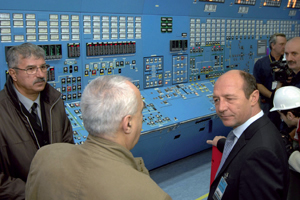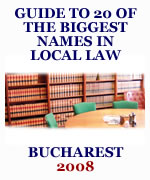 |
Old fashioned nuclear tech under attack
Romania faces criticism for building nuclear reactors with out-dated technology, finds Ana-Maria Nitoi
 |
|
Two nuclear reactors in Romania set to produce electricity are based on out-dated technology, critics of the power resource tell The Diplomat.
The nuclear power plant in Cernavoda, Constanta county, has plans to build two more reactors based on the same Canadian CANDU technology used in its existing two reactors.
Power companies such as Belgium’s Electrabel, Italy’s Enel, Spain’s Iberdrola, the Czech Republic’s CEZ, Arcelor-Mittal Romania and Germany’s RWE are six firms in the process of establishing a joint venture with the Romanian state’s nuclear power company Nuclearelectrica to raise the 2.2 billion Euro needed for the construction of the reactors.
When the new units start operation, most probably in 2015, 30 per cent of Romania’s electricity demand could be supplied by nuclear power. Now about 15 per cent of the country’s electricity demand is covered by Cernavoda’s two active reactors.
The two CANDU reactors Romania plans to build in the next years are Generation 2.
But the Canadian nuclear regulator has announced it will no longer give construction permits for the same technology in its own country, because it does not meet modern safety standards.
The Romanian state is also shopping around for technology to build a second nuclear power plant, probably in Fagaras or Piatra Neamt.
“Building a Generation 2 reactor for a second nuclear power plant would only be possible if one sees Romania as a second class country that can make do with an outdated level of nuclear safety,” argues Jan Haverkamp, an expert on energy issues in central Europe for Greenpeace in Brussels. “This is already the case with the proposed finalisation of the construction of Cernavoda units 3 and 4.”
The CANDU reactors at Cernavoda were built based on the expertise of Canadian nuclear engineers from the Atomic Energy of Canada Limited (AECL). Also available is the more expensive Generation 3 reactor ACR 1000, which features modern safety upgrades. “But ACR 1000 is still on the drawing board and currently faces large engineering problems,” argues Haverkamp.
Mircea Metes, chief of department in state company Nuclearelectrica, says that even in Canada, CANDU nuclear power plants are not the only possible option.
The company that operates the most nuclear power plants based on CANDU, Ontario Hydro, is preparing an auction to develop new power plants. Ontario Hydro has asked not only AECL to come forward and make offers, but also other suppliers. “There are countries such as Argentina, South Korea and China that use more nuclear technologies to produce electricity, alongside CANDU,” Metes says.
Romania’s plan to build a second nuclear power plant is part of a strategy to reduce the country’s dependency on Russian gas and concentrate more on nuclear power and renewable energy. Currently, around 40 per cent of the gas in Romania used countrywide to produce electricity is Russian.
The Romanian authorities are searching the market to find the best suited nuclear technology. The European Pressurised Reactor (EPR) is another possibility for Romanian authorities to consider for the new nuclear power plant, which is planned to start construction in 2020.
Last month Prime Minister Calin Popescu Tariceanu signed a cooperation agreement with French counterpart Francois Fillon for France to build Romania’s second nuclear power plant. The two heads of Government did not want to disclose any further details, but previously French energy giant Areva, which uses EPR, has shown interest in this project.
An EPR being built in Finland has seen over 1,500 safety infringements during the first three years of construction and building time and budget are 50 per cent larger than the original estimates.
EPR uses low-enriched uranium and light water, while CANDU uses natural uranium and heavy water. Romania has some natural uranium resources and also the facilities to produce fuel for its nuclear plant at Cernavoda. But if the Romanian state decides to use EPR for its second nuclear plant, it must buy the slightly enriched uranium on the open market.
“The fact that none of the recent Romanian energy policies seriously looked into this direction, shows Romania is run by a short-sighted lobby with too much influence in the Ministry of Economy and Finance and neither Cernavoda 3 and 4, nor any other new nuclear power station are necessary for Romania, if intelligent choices are made now,” argues Greenpeace’s EU policy campaigner.
|
|
|
|
|
 |
| ADDRESS CHANGE |
Starting with May, 5th the new adress of The Diplomat Bucharest magazine is 187-189 Traian
Street, Sc. 2, 6 Floor, Ap. 38 , 2 District, Bucharest, Romania
| | MEMBERS SECTION |  |
|
|
| THE DIPLOMAT EVENTS |
|
|
| LINKS |
|
|
|


















